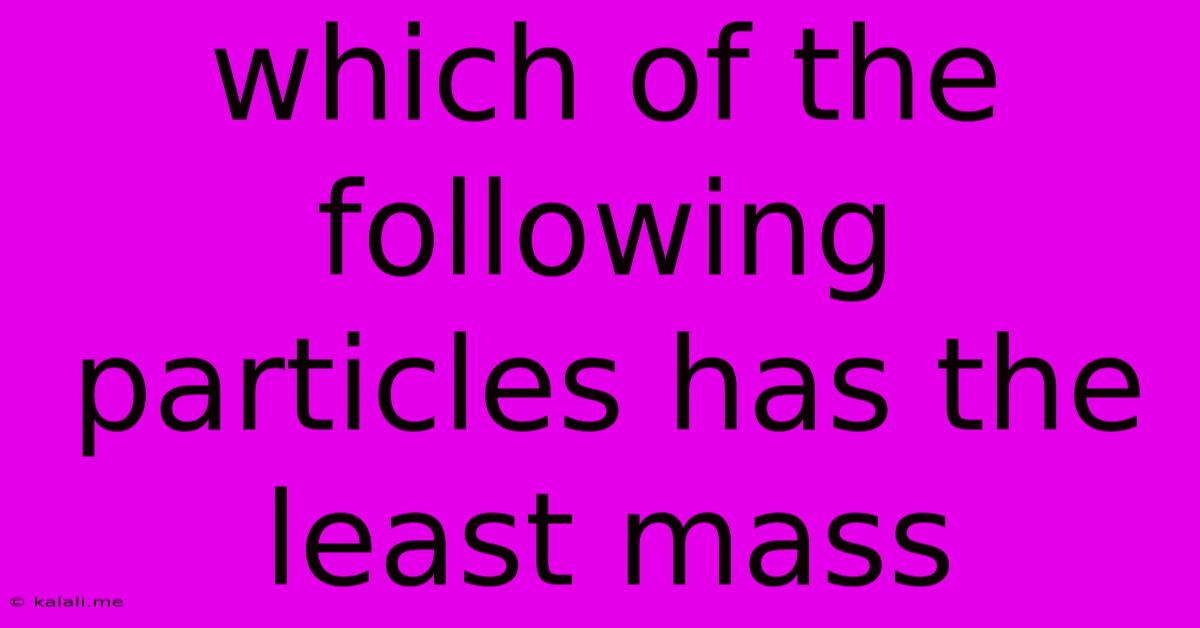Which Of The Following Particles Has The Least Mass
Kalali
Jun 15, 2025 · 2 min read

Table of Contents
Which of the Following Particles Has the Least Mass? A Deep Dive into Subatomic Particles
This article explores the fascinating world of subatomic particles and answers the question: which particle boasts the least mass? We'll delve into the intricacies of particle physics, comparing the masses of various fundamental particles and exploring the implications of their relative sizes. Understanding particle masses is crucial for comprehending the fundamental forces of nature and the structure of the universe.
The answer isn't straightforward, as the "least mass" can depend on the context and the definition of "mass." We'll consider both rest mass (the mass of a particle at rest) and effective mass (which can vary based on interactions).
The Contenders: A Lineup of Subatomic Particles
Several particles vie for the title of "lightest." Let's examine some key players:
- Electrons: These fundamental particles carry a negative charge and are a key component of atoms. They have a relatively small mass.
- Neutrinos: These elusive, neutral particles interact very weakly with matter. There are three types (or "flavors"): electron neutrinos, muon neutrinos, and tau neutrinos. Their masses are incredibly tiny, posing a significant challenge for measurement.
- Photons: These massless particles are the carriers of the electromagnetic force and constitute light. Their rest mass is precisely zero.
The Winner: Neutrinos – The Ultralight Champions
While photons have zero rest mass, neutrinos are generally considered to have the least nonzero mass. The exact masses of neutrinos are still under investigation, but they are known to be incredibly small, many orders of magnitude less than the mass of an electron. This makes them incredibly difficult to detect and study.
It's important to clarify that the absolute mass of neutrinos is still a subject of ongoing research and experimental measurement. The difference between neutrino masses and zero is so minuscule that it requires extremely sensitive experiments to detect. Different neutrino types (flavors) likely also have slightly different masses.
Implications of Infinitesimally Small Masses
The incredibly small mass of neutrinos has significant implications for our understanding of cosmology and astrophysics. Their sheer abundance in the universe, despite their minimal mass, could play a vital role in the formation of large-scale structures and the overall evolution of the cosmos.
Furthermore, understanding the mass hierarchy of neutrinos and their oscillation properties (their ability to change flavors) helps refine the Standard Model of particle physics, a cornerstone of our understanding of fundamental interactions.
Conclusion: A Journey into the Subatomic Realm
Determining the particle with the least mass requires careful consideration of the context and the definition of "mass." While photons are massless, neutrinos, with their extremely small, but nonzero mass, hold the title for the least massive particle with mass. Ongoing research continues to refine our understanding of these elusive particles and their impact on the universe. The quest to precisely measure neutrino masses remains a fascinating frontier in particle physics.
Latest Posts
Latest Posts
-
How Many Cups Are In A Cool Whip Container
Jul 30, 2025
-
1 Syllable Words That Start With S
Jul 30, 2025
-
How Many Sq Ft Is 34 Acres
Jul 30, 2025
-
How Much Does A Full Concrete Truck Weigh
Jul 30, 2025
-
What Is The Net Ionic Equation Of 2h So42
Jul 30, 2025
Related Post
Thank you for visiting our website which covers about Which Of The Following Particles Has The Least Mass . We hope the information provided has been useful to you. Feel free to contact us if you have any questions or need further assistance. See you next time and don't miss to bookmark.